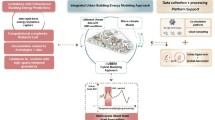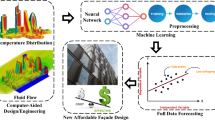Abstract
The air infiltration rate of buildings strongly influences indoor environment and energy consumption. In this study, several traditional methods for determining the air infiltration rate were compared, and their accuracy in different scenarios was examined. Additionally, a method combining computational flow dynamics (CFD) with the Swami and Chandra (S-C) model was developed to predict the influence of the surrounding environment on the air infiltration rate. Two buildings in Dalian, China, were selected: one with a simple surrounding environment and the other with a complex surrounding environment; their air infiltration rates were measured. The test results were used to validate the accuracy of the air infiltration rate solution models in different urban environments. For the building with a simple environment, the difference between the simulation and experimental results was 0.86%–22.52%. For the building with a complex environment, this difference ranged from 17.42% to 159.28%. We found that most traditional models provide accurate results for buildings with simple surrounding and that the simulation results widely vary for buildings with complex surrounding. The results of the method of combining CFD with the S-C model were more accurate, and the relative error between the simulation and test results was 10.61%. The results indicate that the environment around the building should be fully considered when calculating the air infiltration rate. The results of this study can guide the application of methods of determining air infiltration rate.
Similar content being viewed by others
Abbreviations
- ACH:
-
air change per hour (h−1)
- A e :
-
effective infiltration area (m2)
- C out :
-
outdoor CO2 concentration (ppm)
- C t :
-
CO2 concentration at the end of the test (ppm)
- \({c_{{t_0}}}\) :
-
CO2 concentration at the beginning of the test (ppm)
- C A :
-
actual flow coefficient
- C P :
-
pressure coefficient
- C Q :
-
flow coefficient
- C S :
-
thermal-pressure-induced infiltration coefficient
- C W :
-
wind-induced infiltration coefficient
- F schedule :
-
user-defined work schedule
- H :
-
building height (m)
- I design :
-
coefficient of air infiltration
- n :
-
airflow index
- p dyn :
-
dynamic pressure (Pa)
- ΔP in-out :
-
internal/external pressure difference (Pa)
- Q :
-
air infiltration rate (m3/s)
- t :
-
end of CO2 concentration decay (h)
- t 0 :
-
beginning of CO2 concentration decay (h)
- ΔT :
-
indoor and outdoor temperature difference (°C)
- V inflow :
-
inflow wind speed (m/s)
- V ref :
-
velocity at reference height (m/s)
References
Airaksinen M, Pasanen P, Kurnitski J, et al. (2004). Microbial contamination of indoor air due to leakages from crawl space: a field study. Indoor Air, 14: 55–64.
ANSYS (2019). ANSYS Fluent 19. R2 User’s Guide.
ASHRAE (2013). ASHRAE Handbook of Fundamentals. Atlanta, GA, USA: American Society of Heating, Refrigerating and Air Conditioning Engineers.
Binamu A (2002). Integrating building design properties “air tightness” and ventilation heat recovery for minimum heating energy consumption in cold climates. PhD Thesis, Tampere University of Technology, Finland.
Blocken B, Persoon J (2009). Pedestrian wind comfort around a large football stadium in an urban environment: CFD simulation, validation and application of the new Dutch wind nuisance standard. Journal of Wind Engineering and Industrial Aerodynamics, 97: 255–270.
Bobenhausen W (1994). Heat Loss from Buildings: Simplified Design of HVAC Systems. New York: John Wiley & Sons.
Charisi S, Waszczuk M, Thiis TK (2021). Determining building-specific wind pressure coefficients to account for the microclimate in the calculation of air infiltration in buildings. Advances in Building Energy Research, 15: 368–389.
Coblentz CW, Achenbach PR (1963). Field measurement of air infiltration in ten electrically-heated houses. ASHRAE Transactions, 69(1): 358–363.
Dai HK, Chen C (2022). Air infiltration rates in residential units of a public housing estate in Hong Kong. Building and Environment, 219: 109211.
De Wit MS (2001). Uncertainty in predictions of thermal comfort in buildings. PhD Thesis, Delft University of Technology, the Netherlands.
Dogan T, Kastner P (2021). Streamlined CFD simulation framework to generate wind-pressure coefficients on building facades for airflow network simulations. Building Simulation, 14: 1189–1200.
Dols WS, Emmerich SJ, Polidoro BJ (2016). Coupling the multizone airflow and contaminant transport software CONTAM with EnergyPlus using co-simulation. Building Simulation, 9: 469–479.
Dols WS, Polidoro BJ (2006). CONTAM 3.2 User Guide and Program Documentation. Gaithersburg, MD, USA: National Institute of Standards and Technology.
Feustel HE (1999). COMIS—An international multizone air-flow and contaminant transport model. Energy and Buildings, 30: 3–18.
Franke J, Hellsten A, Schlunzen KH, et al. (2011). The COST 732 Best Practice Guideline for CFD simulation of flows in the urban environment: A summary. International Journal of Environment and Pollution, 44: 419.
Gao N, Wang R, Wu Y, et al. (2023). Study on impact factors of tracer gas method in investigations of gaseous pollutant transport and building ventilation. Building Simulation, 16: 413–426.
Grosso M (1992). Wind pressure distribution around buildings: A parametrical model. Energy and Buildings, 18: 101–131.
Hayati A, Mattsson M, Sandberg M (2017). Single-sided ventilation through external doors: Measurements and model evaluation in five historical churches. Energy and Buildings, 141: 114–124.
Hu S, Jiang Y, Yan D (2021). China Building Energy Use and Carbon Emission Yearbook 2021. Beijing: China Architecture and Building Press.
ISO 9972 (2015). ISO 9972:2015. Thermal performance of buildings—Determination of air permeability of buildings—Fan pressurization method. BSI Standards Publication.
Ji Y, Duanmu L, Liu Y, et al. (2020). Air infiltration rate of typical zones of public buildings under natural conditions. Sustainable Cities and Society, 61: 102290.
Ji Y, Duanmu L, Hu S (2024). Measurement and analysis of airtightness safeguard measures for typical ultra-low energy buildings. Energy and Built Environment, 5: 348–363.
Johnston D, Miles-Shenton D (2018). The airtightness and air leakage characteristics of new UK holiday homes. Building Services Engineering Research and Technology, 39: 343–361.
Jokisalo J, Kalamees T, Kurnitski J, et al. (2008). A comparison of measured and simulated air pressure conditions of a detached house in a cold climate. Journal of Building Physics, 32: 67–89.
Jurelionis A, Bouris D (2016). Impact of urban morphology on infiltration-induced building energy consumption. Energies, 9: 177.
Li X, Zhou W, Duanmu L (2021). Research on air infiltration predictive models for residential building at different pressure. Building Simulation, 14: 737–748.
Li W, Subiantoro A, McClew I, et al. (2022). CFD simulation of wind and thermal-induced ventilation flow of a roof cavity. Building Simulation, 15: 1611–1627.
Liddament MW (1986). Air infiltration calculation techniques—An application guide. Coventry, UK: Air infiltration and Ventilation Centre (AIVC).
Liu S, Pan W, Zhao X, et al. (2018). Influence of surrounding buildings on wind flow around a building predicted by CFD simulations. Building and Environment, 140: 1–10.
Liu X, Liu X, Zhang T, et al. (2019). On-site measurement of winter indoor environment and air infiltration in an airport terminal. Indoor and Built Environment, 28: 564–578.
Liu X, Liu X, Zhang T, et al. (2020). Comparison of winter air infiltration and its influences between large-space and normal-space buildings. Building and Environment, 184: 107183.
Lstiburek J, Pressnail K, Timusk J (2002). Air pressure and building envelopes. Journal of Thermal Envelope and Building Science, 26: 53–91.
Oladokun MO, Ali M, Osman SB, Lin Z (2017). Indoor mould growth prediction using coupled computational fluid dynamics and mould growth model. Building Simulation, 10: 551–562.
Patankar SV (1980). Numerical Heat Transfer and Fluid Flow. Washington, DC: Hemisphere Publishing Corporation.
Ricketts L (2014). A field study of airflow in a high-rise multi-unit residential building. Master Thesis, University of Waterloo, Canada.
Shaw C-Y (1981). A correlation between air infiltration and air tightness for houses in a developed residential area. ASHRAE Transactions, 87(2): 333–341.
Sherman MH, Grimsrud DT (1980). Infiltration-pressurization correlation: Simplified physical modeling. ASHRAE Transaction, 86(1): 778–807.
Shih TH, Liou WW, Shabbir A, et al. (1995). A new k-ε eddy viscosity model for high Reynolds number turbulent flows. Computers & Fluids, 24: 227–238.
Stabile L, Dell’Isola M, Frattolillo A, et al. (2016). Effect of natural ventilation and manual airing on indoor air quality in naturally ventilated Italian classrooms. Building and Environment, 98: 180–189.
Swami MV, Chandra S (1987). Procedures for calculating natural ventilation airflow rates in buildings. Technical Report, Florida Solar Energy Center, USA.
Walker IS, Wilson DJ (1998). Field validation of algebraic equations for stack and wind driven air infiltration calculations. HVAC&R Research, 4: 119–139.
Woods JE, Maldonado B, Reynolds GL (1981). How ventilation influences energy consumption and indoor air quality. ASHRAE Journal, 23(6): 40–43.
Yang X, Zhao L, Bruse M, et al. (2012). An integrated simulation method for building energy performance assessment in urban environments. Energy and Buildings, 54: 243–251.
Zheng S, Wang Y, Zhai Z, et al. (2021). Characteristics of wind flow around a target building with different surrounding building layers predicted by CFD simulation. Building and Environment, 201: 107962.
Zhuang R, Li X, Tu J (2014). CFD study of the effects of furniture layout on indoor air quality under typical office ventilation schemes. Building Simulation, 7: 263–275.
Acknowledgements
This work was supported by the National Natural Science Foundation of China (51838007), and the Tsinghua-Toyota Joint Research Institute Inter-disciplinary Program.
Author information
Authors and Affiliations
Contributions
Material preparation, data collection and analysis were performed by Shu Zheng, Xiujiao Song, Lin Duanmu, Yu Xue, and Xudong Yang. The first draft of the manuscript was written by Shu Zheng and all authors commented on previous versions of the manuscript. All authors read and approved the final manuscript.
Corresponding authors
Ethics declarations
Declaration of competing interest
The authors have no competing interests to declare that are relevant to the content of this article. Xudong Yang is the founding Editor-in-Chief of Building Simulation.
Ethical approval
This study does not contain any studies with human or animal subjects performed by any of the authors.
Rights and permissions
About this article
Cite this article
Zheng, S., Song, X., Duanmu, L. et al. Comparison of models to predict air infiltration rate of buildings with different surrounding environments. Build. Simul. (2024). https://doi.org/10.1007/s12273-024-1118-5
Received:
Revised:
Accepted:
Published:
DOI: https://doi.org/10.1007/s12273-024-1118-5




